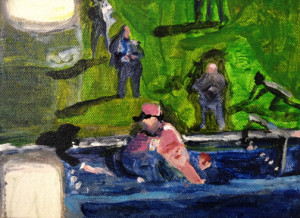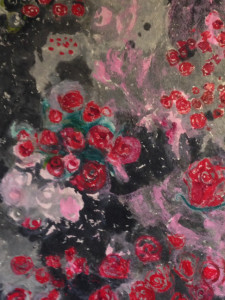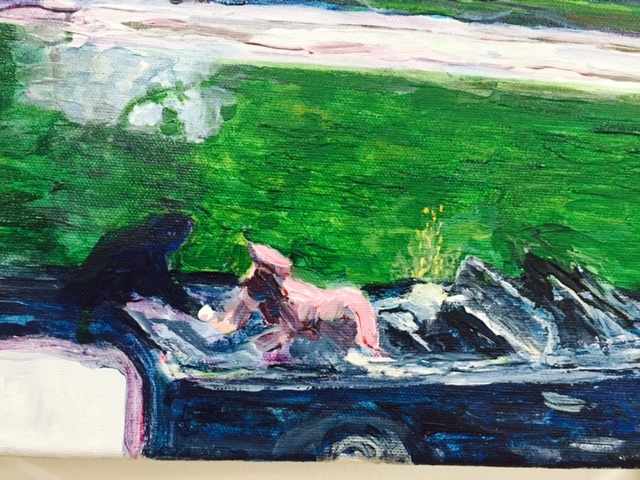If there was a central flaw or fracture to Karen Finley’s The Jackie Look, it had mostly to do with a lack of clarity of its dramatic objective and trajectory. Finley seemed to be trying to both deconstruct an icon (or more precisely its refractions and reflections in a morphing cultural landscape) and at the same time single out one of its iterations as a kind of perspectival vanishing point (the Jacqueline Onassis of the mid- to late-1970s). This was complicated by the factual history of Onassis’s own editorial role in the iconography and controlling the narrative around it. No less daunting was the problem of sorting out and making sense of the discrete layers of cultural and psychological trauma the performance was attempting to address.
 Finley’s gallery exhibition, Love Field, at Coagula Curatorial, afforded her the space (and time) to sort out those issues and moments, and break them down into individual images (projected and received), gestures and souvenirs that both capture an essential cultural/historical moment and have the potential to expand in a limitless psychological space. As the title implies, she goes directly to the instigating – itself summing up an entire cultural epoch, and layered with irony: isolating the gesture of the red roses with their after-the-fact portent of the tragedy that would ensue; separating out critical frames of the Zapruder film where the gunshots are seen to reach their targets in the Presidential limousine, with Jackie reacting and scrambling out of her seat and across the back of the car. Finley titles Zapruder still series, Grassy Knoll, deliberately incorporating the blurred surround of grass island, traffic and street/sidewalk detail, the micro-incident of confused by-standers wandering around the focal point, only vaguely cognizant of the violence erupting in their midst. They’re singular and extraordinary, with a delicacy that contrasts strikngly with the violence of their subject.
Finley’s gallery exhibition, Love Field, at Coagula Curatorial, afforded her the space (and time) to sort out those issues and moments, and break them down into individual images (projected and received), gestures and souvenirs that both capture an essential cultural/historical moment and have the potential to expand in a limitless psychological space. As the title implies, she goes directly to the instigating – itself summing up an entire cultural epoch, and layered with irony: isolating the gesture of the red roses with their after-the-fact portent of the tragedy that would ensue; separating out critical frames of the Zapruder film where the gunshots are seen to reach their targets in the Presidential limousine, with Jackie reacting and scrambling out of her seat and across the back of the car. Finley titles Zapruder still series, Grassy Knoll, deliberately incorporating the blurred surround of grass island, traffic and street/sidewalk detail, the micro-incident of confused by-standers wandering around the focal point, only vaguely cognizant of the violence erupting in their midst. They’re singular and extraordinary, with a delicacy that contrasts strikngly with the violence of their subject.
From the historical specificity of the Zapruder images (the subject that belongs to history), Finley moves on to the psychological open-endedness of the ‘Jackie icon’ (the subject that belongs to all of us, both individually and collectively). Here, directly contradicting the Warhol repetitions of Jackie from Love Field through the aftermath, Finley presents the sparest, schematic silhouette, almost a cartoon: the Jackie of random projection and speculation; the Jackie of our guilty subconscious, of blank and idle unconscious; our Madonna del Parto of post-traumatic mass media stress disorder; the ‘ghost-Jackies’ of distorted memory and wishful thinking; our blurred, color-by-your-own-numbers screen sphinx. Some of the drawings have a psycho-therapeutic aspect; a few, the quality of semi-conscious automatic drawing. However cartoon-like they may come across, they never veer into caricature.
And not incidentally, a bit of trust. Finley’s hand appears variously sure, wavering, firm, delicate – and ultimately unhesitant. It’s everything her performance was building towards, but pulled away from. There was a point in Finley’s Jackie Look performance when she cut loose to a film of Sylvester performing “You Make Me Feel (Mighty Real)” – the point of highest vulnerability and highest potential impact (even violence). Setting these forces in play is a kind of ignition and never without risk – even in a ‘safe place,’ whether theatrical or therapeutic. But it’s the only way we get to see the fireworks.


